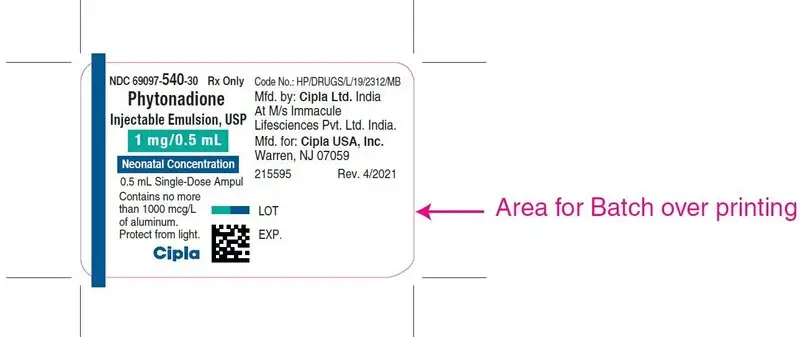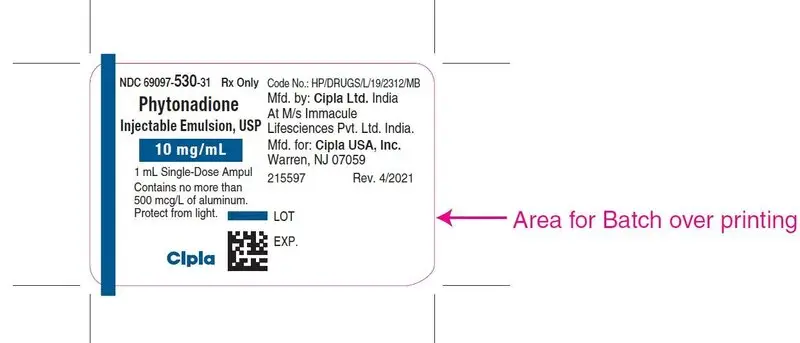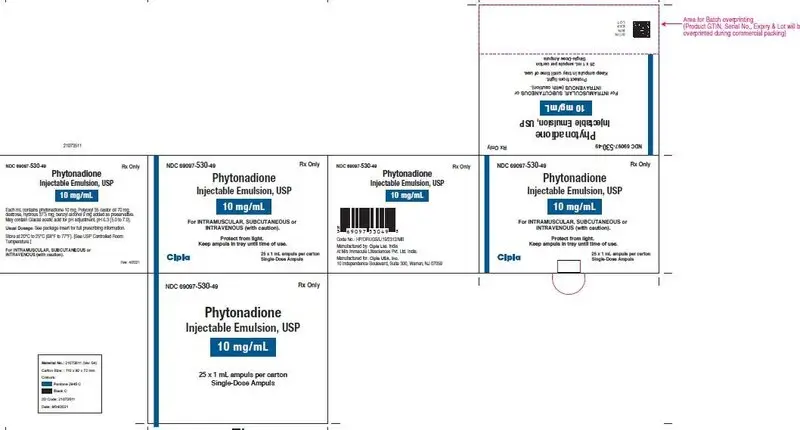Drug Detail:Phytonadione (monograph) (Medically reviewed)
Drug Class:
Highlights of Prescribing Information
PHYTONADIONE injectable emulsion, for intravenous, intramuscular, and subcutaneous use.
Initial U.S. Approval: 1960
WARNING-HYPERSENSITIVITY REACTIONS WITH INTRAVENOUS AND INTRAMUSCULAR USE
See full prescribing information for complete boxed warning.
Fatal hypersensitivity reactions, including anaphylaxis, have occurred during and immediately after INTRAVENOUS and INTRAMUSCULAR injection of phytonadione injectable emulsion. Reactions have occurred despite dilution to avoid rapid infusion and upon first and subsequent doses. Avoid the intravenous and intramuscular routes of administration unless the subcutaneous route is not feasible and the serious risk is justified. (5.1)
Indications and Usage for Phytonadione
Phytonadione injectable emulsion is a vitamin K replacement indicated for the treatment of the following coagulation disorders which are due to faulty formation of factors II, VII, IX and X when caused by vitamin K deficiency or interference with vitamin K activity.
- Anticoagulant-induced hypoprothrombinemia deficiency caused by coumarin or indanedione derivatives; (1.1)
- Hypoprothrombinemia due to antibacterial therapy; (1.1)
- Hypoprothrombinemia secondary to factors limiting absorption or synthesis of vitamin K, e.g., obstructive jaundice, biliary fistula, sprue, ulcerative colitis, celiac disease, intestinal resection, cystic fibrosis of the pancreas, and regional enteritis; (1.1)
- Other drug-induced hypoprothrombinemia where is it definitely shown that the result is due to interference with vitamin K metabolism, e.g., salicylates. (1.1)
Phytonadione injectable emulsion is indicated for prophylaxis and treatment of vitamin K-deficiency bleeding in neonates. (1.2)
Phytonadione Dosage and Administration
- Administer phytonadione injectable emulsion by the subcutaneous route, whenever possible. (2.1)
- When intravenous administration is unavoidable, inject the drug very slowly, not exceeding 1 mg per minute. (2.1)
Dosage Forms and Strengths
Injection: 2 mg/mL and 10 mg/mL single-dose ampuls. (3)
Contraindications
Hypersensitivity to any component of this medication. (4)
Warnings and Precautions
- Risk of Serious Adverse Reactions in Infants due to Benzyl Alcohol Preservative: Use benzyl alcohol-free formulations in neonates and infants, if available. (5.1)
- Cutaneous Reactions: May occur with parenteral use. Discontinue drug and manage medically. (5.3)
Adverse Reactions/Side Effects
Most common adverse reactions are cyanosis, diaphoresis, dizziness, dysgeusia, dyspnea, flushing, hypotension and tachycardia. (6)
To report SUSPECTED ADVERSE REACTIONS, contact Cipla Ltd at 1-866-604-3268, or FDA at 1-800-FDA-1088 or www.fda.gov/medwatch.
Drug Interactions
Anticoagulants: May induce temporary resistance to prothrombin-depressing anticoagulants. (7)
Use In Specific Populations
- Pregnancy: If available, use the preservative-free formulation in pregnant women. (8.1)
- Lactation: If available, use the preservative-free formulation in lactating women. (8.2)
- Pediatric Use: The safety and effectiveness of phytonadione injectable emulsion in pediatric patients from 6 months to 17 years have not been established. (8.4)
See 17 for PATIENT COUNSELING INFORMATION.
Revised: 5/2022
Related/similar drugs
Vitamin K1, Mephyton, AquamephytonFull Prescribing Information
1. Indications and Usage for Phytonadione
1.1 Treatment of Hypoprothrombinemia Due to Vitamin K Deficiency or Interference
- anticoagulant-induced hypoprothrombinemia caused by coumarin or indanedione derivatives;
- hypoprothrombinemia due to antibacterial therapy;
- hypoprothrombinemia secondary to factors limiting absorption or synthesis of vitamin K, e.g., obstructive jaundice, biliary fistula, sprue, ulcerative colitis, celiac disease, intestinal resection, cystic fibrosis of the pancreas, and regional enteritis;
- other drug-induced hypoprothrombinemia where it is definitely shown that the result is due to interference with vitamin K metabolism, e.g., salicylates.
2. Phytonadione Dosage and Administration
2.1 Dosing Considerations
Monitor international normalized ratio (INR) regularly and as clinical conditions indicate. Use the lowest effective dose of phytonadione injectable emulsion.
The coagulant effects of phytonadione injectable emulsion are not immediate; improvement of INR may take 1-8 hours. Interim use of whole blood or component therapy may also be necessary if bleeding is severe.
Whenever possible, administer benzyl alcohol-free formulations in pediatric patients [see Warnings and Precautions (5.2), Use in Specific Populations (8.4)].
When phytonadione injectable emulsion is used to correct excessive anticoagulant-induced hypoprothrombinemia, anticoagulant therapy still being indicated, the patient is again faced with the clotting hazards existing prior to starting the anticoagulant therapy. Phytonadione is not a clotting agent, but overzealous therapy with phytonadione injectable emulsion may restore conditions which originally permitted thromboembolic phenomena. Dosage should be kept as low as possible, and INR should be checked regularly as clinical conditions indicate.
2.2 Recommended Dosage for Coagulation Disorders from Vitamin K Deficiency or Interference
- Anticoagulant-Induced Hypoprothrombinemia: Phytonadione injectable emulsion 2.5 mg to 10 mg or more subcutaneously, intramuscularly, or intravenously. Up to 25 mg to 50 mg may be administered as a single dose.
- Hypoprothrombinemia Due to Other Causes (Non-Anticoagulation-Induced Hypoprothrombinemia): Phytonadione injectable emulsion 2.5 mg to 25 mg or more intravenously, intramuscularly, or subcutaneously. Up to 50 mg may be administered as a single dose.
2.3 Recommended Dosage for Prophylaxis and Treatment of Vitamin K Deficiency Bleeding in Neonates
Prophylaxis of Vitamin K-Deficiency Bleeding in Neonates
The recommended dosage of phytonadione injectable emulsion is 0.5 mg to 1 mg within one hour of birth for a single dose.
Treatment of Vitamin K Deficiency Bleeding in Neonates
The recommended dosage of phytonadione injectable emulsion is 1 mg given either subcutaneously or intramuscularly. Consider higher doses if the mother has been receiving oral anticoagulants.
A failure to respond (shortening of the INR in 2 to 4 hours) may indicate another diagnosis or coagulation disorder.
2.4 Directions for Dilution
When diluted, start administration of phytonadione injectable emulsion immediately after dilution.
Discard unused portions of diluted solution as well as unused contents of the ampul.
Protect phytonadione injectable emulsion from light at all times.
Parenteral drug products should be inspected visually for particulate matter and discoloration prior to administration, whenever solution and container permit.
5. Warnings and Precautions
5.2 Risk of Serious Adverse Reaction in Infants due to Benzyl Alcohol Preservative
When prescribing phytonadione injectable emulsion in infants, consider the combined daily metabolic load of benzyl alcohol from all sources including phytonadione injectable emulsion (contains 9 mg of benzyl alcohol per mL) and other drugs containing benzyl alcohol. The minimum amount of benzyl alcohol at which serious adverse reactions may occur is not known [see Use in Specific Populations (8.1, 8.2 and 8.4)].
6. Adverse Reactions/Side Effects
The following serious adverse reactions are described elsewhere in the labeling:
- Hypersensitivity Reactions [see Warnings and Precautions (5.1)]
- Cutaneous Reactions [see Warnings and Precautions (5.3)]
6.1 Clinical Trials and Post-Marketing Experience
The following adverse reactions have been identified during post-approval use of phytonadione injectable emulsion. Because these reactions were reported voluntarily from a population of uncertain size, it is not always possible to reliably estimate their frequency or establish a causal relationship to drug exposure.
Cardiac Disorders: Tachycardia, hypotension.
General disorders and administration site conditions: Generalized flushing; pain, swelling, and tenderness at injection site.
Hepatobiliary Disorders: Hyperbilirubinemia
Immune System Disorders: Fatal hypersensitivity reactions, anaphylactic reactions.
Neurologic: Dysgeusia, dizziness.
Pulmonary: Dyspnea.
Skin and Subcutaneous Tissue Disorders: Erythema, pruritic plaques, scleroderma-like lesions, erythema perstans.
Vascular: Cyanosis.
7. Drug Interactions
Phytonadione injectable emulsion may induce temporary resistance to prothrombin-depressing anticoagulants, especially when larger doses of phytonadione injectable emulsion are used. Should this occur, higher doses of anticoagulant therapy may be needed when resuming anticoagulant therapy, or a change in therapy to a different class of anticoagulant may be necessary (i.e., heparin sodium).
Phytonadione injectable emulsion does not affect the anticoagulant action of heparin.
8. Use In Specific Populations
8.1 Pregnancy
Phytonadione injectable emulsion contains benzyl alcohol, which has been associated with gasping syndrome in neonates. The preservative benzyl alcohol can cause serious adverse events and death when administered intravenously to neonates and infants. If phytonadione injectable emulsion is needed during pregnancy, consider using a benzyl alcohol-free formulation [see Warnings and Precautions (5.2), Use in Specific Populations (8.4)].
Published studies with the use of phytonadione during pregnancy have not reported a clear association with phytonadione and adverse developmental outcomes [see Data]. There are maternal and fetal risks associated with vitamin K deficiency during pregnancy [see Clinical Considerations]. Animal reproduction studies have not been conducted with phytonadione.
The estimated background risk for the indicated population is unknown. All pregnancies have a background risk of birth defect, loss, or other adverse outcomes. In the U.S. general population, the estimated background risk of major birth defects and miscarriage in clinically recognized pregnancies is 2-4% and 15-20%, respectively.
Clinical Considerations
Disease-associated maternal and/or embryo/fetal risk
Pregnant women with vitamin K deficiency hypoprothrombinemia may be at an increased risk for bleeding diatheses during pregnancy and hemorrhagic events at delivery. Subclinical maternal vitamin K deficiency during pregnancy has been implicated in rare cases of fetal intracranial hemorrhage.
Data
Human Data
Phytonadione has been measured in cord blood of infants whose mothers were treated with phytonadione during pregnancy in concentrations lower than seen in maternal plasma. Administration of vitamin K1 to pregnant women shortly before delivery increased both maternal and cord blood concentrations. Published data do not report a clear association with phytonadione and adverse maternal or fetal outcomes when used during pregnancy. However, these studies cannot definitively establish the absence of any risk because of methodologic limitations including small sample size and lack of blinding.
Animal Data
In pregnant rats receiving vitamin K1 orally, fetal plasma and liver concentrations increased following administration, supporting placental transfer.
8.2 Lactation
Phytonadione injectable emulsion contains benzyl alcohol. If available, preservative-free phytonadione injectable emulsion is recommended when phytonadione injectable emulsion is needed during lactation [see Warnings and Precautions (5.2), Use in Specific Populations (8.4)].
Phytonadione is present in breastmilk. There are no data on the effects of phytonadione injectable emulsion on the breastfed child or on milk production. The developmental and health benefits of breastfeeding should be considered along with the clinical need for phytonadione injectable emulsion and any potential adverse effects on the breastfed child from phytonadione injectable emulsion or from the underlying maternal condition.
8.4 Pediatric Use
Serious adverse reactions including fatal reactions and the "gasping syndrome" occurred in premature neonates and infants in the intensive care unit who received drugs containing benzyl alcohol as a preservative. In these cases, benzyl alcohol dosages of 99 to 234 mg/kg/day produced high levels of benzyl alcohol and its metabolites in the blood and urine (blood levels of benzyl alcohol were 0.61 to 1.378 mmol/L). Additional adverse reactions included gradual neurological deterioration, seizures, intracranial hemorrhage, hematologic abnormalities, skin breakdown, hepatic and renal failure, hypotension, bradycardia, and cardiovascular collapse. Preterm, low-birth weight infants may be more likely to develop these reactions because they may be less able to metabolize benzyl alcohol.
When prescribing phytonadione injectable emulsion in infants consider the combined daily metabolic load of benzyl alcohol from all sources including phytonadione injectable emulsion (phytonadione injectable emulsion contains 9 mg of benzyl alcohol per mL) and other drugs containing benzyl alcohol. The minimum amount of benzyl alcohol at which serious adverse reactions may occur is not known [see Warnings and Precautions (5.2)].
Whenever possible, use preservative-free phytonadione formulations in neonates. The preservative benzyl alcohol has been associated with serious adverse events and death in pediatric patients. Premature and low-birth weight infants may be more likely to develop toxicity.
11. Phytonadione Description
Phytonadione is 2-methyl-3-phytyl-1, 4-naphthoquinone. Its empirical formula is C31H46O2 and its molecular structure is:

12. Phytonadione - Clinical Pharmacology
12.1 Mechanism of Action
In normal animals and humans, phytonadione is virtually devoid of activity. However, in animals and humans deficient in vitamin K, the pharmacological action of vitamin K is related to its normal physiological function, that is, to promote the hepatic biosynthesis of vitamin K dependent clotting factors.
12.3 Pharmacokinetics
Phytonadione is readily absorbed following intramuscular administration.
Distribution:
After absorption, phytonadione is initially concentrated in the liver, but the concentration declines rapidly. Very little vitamin K accumulates in tissues.
Elimination:
Little is known about the metabolic fate of vitamin K. Almost no free unmetabolized vitamin K appears in bile or urine.
16. How is Phytonadione supplied
| NDC No.
| Container
| Amount of Phytonadione injectable emulsion In Container
| Volume
| Concentration
|
| 69097-540-30 | 1 mL single-dose ampul | 1 mg | 0.5 mL | 2 mg/mL |
| 69097-540-49 | 25 single-dose ampuls per carton | 1 mg | 0.5 mL | 2 mg/mL |
| 69097-530-31 | 1 mL single-dose ampul | 10 mg | 1 mL | 10 mg/mL |
| 69097-530-49 | 25 single-dose ampuls per carton | 10 mg | 1 mL | 10 mg/mL |
Store at 20° to 25°C (68° to 77°F); [see USP Controlled Room Temperature].
Protect phytonadione injectable emulsion from light. Store container in closed original carton until contents have been used.
17. Patient Counseling Information
Inform the patient of the following important risks of phytonadione injectable emulsion:
Serious Hypersensitivity Reactions
Advise the patient and caregivers to immediately report signs of hypersensitivity after receiving phytonadione injectable emulsion [see Warnings and Precautions (5.1)].
Risk of Gasping Syndrome Due to Benzyl Alcohol
Advise the patient and caregivers of the risk of gasping syndrome associated with the use of products that contain benzyl alcohol (including phytonadione injectable emulsion) in neonates, infants, and pregnant women [see Warnings and Precautions (5.2)].
Cutaneous Reactions
Advise the patient and caregivers to report the occurrence of new rashes after receiving phytonadione injectable emulsion. These reactions may be delayed for up to a year after treatment [see Warnings and Precautions (5.3)].
Manufactured by: Cipla Ltd., India
At M/s Immacule Lifesciences Pvt. Ltd. India
Manufactured for:
Cipla USA, Inc.
10 Independence Boulevard, Suite 300,
Warren, NJ 07059
Revised : 04/2021
PACKAGE LABEL.PRINCIPAL DISPLAY PANEL
Phytonadione
Injectable Emulsion, USP
1 mg/0.5 mL
Neonatal Concentration
0.5 mL Single-Dose Ampul
Contains no more
than 1000 mcg/L
of aluminum.
Protect from Light.
Cipla

Phytonadione
Injectable Emulsion, USP10 mg/ mL
1 mL Single-Dose Ampul
Contains no more than
500 mcg/L of aluminum.
Protect from Light.
Cipla

Phytonadione
Injectable Emulsion, USP
1 mg/0.5 mL
Neonatal Concentration
For INTRAMUSCULAR, SUBCUTANEOUS or
INTRAVENOUS (with caution).
Protect from light.
Keep ampuls in tray until time of use.
25 X 0.5 mL ampuls per carton
Single-Dose Ampuls
Cipla

Phytonadione
Injectable Emulsion, USP
10 mg/ mL
For INTRAMUSCULAR, SUBCUTANEOUS or
INTRAVENOUS (with caution).
Protect from light.
Keep ampuls in tray until time of use.
25 X 1 mL ampuls per carton
Single-Dose Ampuls
Cipla

| PHYTONADIONE
phytonadione injection, emulsion |
|||||||||||||||||||||||||
|
|||||||||||||||||||||||||
|
|||||||||||||||||||||||||
|
|||||||||||||||||||||||||
|
|||||||||||||||||||||||||
|
|||||||||||||||||||||||||
| PHYTONADIONE
phytonadione injection, emulsion |
|||||||||||||||||||||||||
|
|||||||||||||||||||||||||
|
|||||||||||||||||||||||||
|
|||||||||||||||||||||||||
|
|||||||||||||||||||||||||
|
|||||||||||||||||||||||||
| Labeler - Cipla USA Inc. (078719707) |
| Registrant - CIPLA LIMITED (650138746) |




